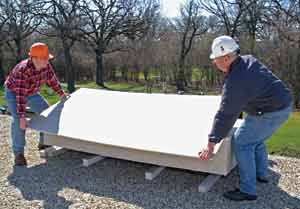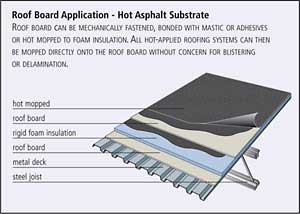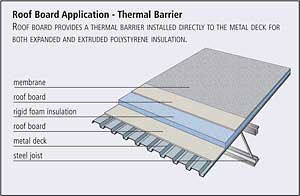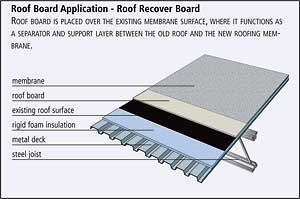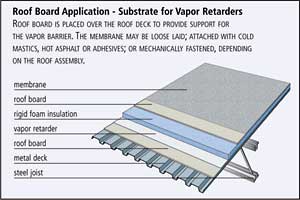Low-Slope Commercial Roofing
Roof Cover Boards Provide Outstanding Performance
![]() Continuing Education
Continuing Education
Use the following learning objectives to focus your study while reading this month’s Continuing Education article.
Learning Objectives - After reading this article, you will be able to:
- Understand how cover boards enhance the performance of commercial roofing systems and assemblies
- Identify several distinct cover board product types and their installation advantages
- Evaluate important criteria when specifying cover boards for different environmental conditions
Cover boards have been a standard component within roof assemblies for more than 20 years, and were developed to enhance the performance of virtually every type of roof system. The use of this relatively thin component, which is typically placed between the roof insulation and the roof membrane, enhances fire resistance, increases wind uplift performance and provides greatly improved resistance to hail and foot traffic.
The evolution of the cover board began with the inception of fluted steel decks as a roofing substrate. Early roof deck types − including wood, concrete and gypsum − are flat, providing a bonding or nailing substrate for the first layer of roofing. The base sheet, as it is called, can be nailed or adhered to the flat surface to form the first layer of the roof assembly. By contrast, a profiled steel deck is formed in a variety of configurations, with varying modules of voids or valleys, called flutes. Deck modules1 range from 2-1/2 to 6 inches across, providing a regular pattern for attachment.
|
||||||||||||||
In order to attach a roof assembly on the profiled deck, some type of flat board is needed to create a bonding surface. Years ago, such boards were formed from cork. The cork boards were bonded to the top flanges of the steel deck with asphalt, over which the roof assembly could be applied. The cork provided a solid walking surface, a good bonding substrate, some thermal insulation value and could be cut to slope for drainage purposes.
Later, other cover board materials entered the market. These materials were lighter and more fire resistant, and included expanded perlite, wood fiber board, exterior-grade gypsum and fiberglass insulation.
With the introduction of foamed plastic insulation, cover boards took on a dual role − providing a fire barrier between the steel deck and the plastic insulation and serving as a suitable bonding layer above the insulation. Foamed insulations, such as urethane, extruded polystyrene and polyisocyanurate, fast became the insulation of choice due to their light weight, fairly good dimensional stability and ease of forming into a tapered material. Both foamed insulation and cover board materials were used in combination to form a slope.
Events of the 1980s
Two significant events occurred in the 1980s that further advanced the use of cover boards.
- The determination that application of hot asphalt or coal tar directly over foamed insulation could result in blistering2.
- A change to Factory Mutual (recently renamed FM Global) Standard 4470 requiring that all insulation be mechanically attached to the steel deck substrate prior to the application of an FM-approved roof assembly.
Significantly, the use of mechanical fasteners and stress plates creates thermal shorts within the insulation. In colder climates, interior condensation forms when the warmer air around the metal fasteners is cooled by the colder exterior temperatures, resulting in moisture formation on the fasteners. The condensed moisture then drips into the interior and rusts the interior components of the screw.
|
||||||||||||||
This problem was solved in a variety of creative ways, such as recessing the screws into the stress plate hub, the use of plastic fasteners and the application of a cover board over the foamed insulation to act as a thermal break between the cold exterior and the warm interior.
As a result of these developments, cover boards became a standard component in commercial roof assemblies. In addition, competing board manufacturers began to promote the use of particular cover board types for their abilities to enhance the performance of specific roof systems.
Comprehensive rounds of wind uplift and fire testing have confirmed the claims of better performance characteristics with the use of some cover boards. Some new cover board materials, including oriented strand board (OSB) and water-resistant gypsum board, entered the market and further broadened the options of interface materials. Materials less than 1/2-inch thick also became available, some of which offer performance characteristics similar to boards with twice their thickness. These options were particularly economical when adhered with hot asphalt or cold adhesive.
Recent Cover Board Developments
In the 1990s, FM Global expanded the uplift ratings of approved roofing systems to include enhanced ratings well above the 90 psf threshold typical before that time.
Furthermore, the protocol for testing these systems was changed from the conventional 5- by 9-foot test table to a much larger 12- by 24-foot table. The larger table minimizes the contribution of the perimeter frame to the tested assembly performance and makes passing at higher pressure levels more difficult. Hence, minor components within the roof assembly, such as mechanical fasteners and cover boards, came to play a key role in advancing the performance of roof assemblies.
|
||||||||||||||
Besides increased fastener densities to improve uplift performance, engineering of newer fasteners and the use of more types of cover boards created a wide variety of enhanced wind uplift systems available to the market.
The lessons of Hurricanes Hugo and Andrew that devastated the Carolina and South Florida coasts have led to more frequent specification of enhanced systems. In the case of South Florida, these enhanced systems became a requirement under the new South Florida Building Code.
Code changes have led to the current published inventory of enhanced high-wind uplift systems, which are supported by credible third-party testing. Cover boards have become a critical component in these assemblies, and quantifiable advantages of one cover board over another have been established. Cover board manufacturers invested significant money in testing to prove the threshold capabilities of their boards. Assemblies incorporating thinner boards, fewer fasteners and less adhesive were tested to maximize performance and minimize costs.
Increased use of cover boards over extended periods of time has revealed problems with some cover boards that are sensitive to moisture degradation. In some cases, minor leaks from the exterior and rising vapor from the interior would condense at the roof membrane (with a relatively low permeability) and wet the cover board materials. Rot, collapse and general deterioration of the cover board would follow, requiring the removal and replacement of the roof membrane, cover board and, in some cases, the underlying insulation.
Even some cover boards touted as water resistant experienced degradation. The water-resistant cover board materials were not necessarily waterproof, but were being used in hostile environments where the boards were destined to fail. In some cases, the water-resistant board was installed in designs where moisture would clearly be present, such as the reroofing of roofs with wet and even saturated insulation.
These experiences led to formulation changes in core materials and the development of surface coatings to limit moisture-related problems, reduce the quantities of adhesive required to apply membranes and enhance adhesion performance. The cost of cover boards increased as more features were added to improve performance levels.
As often happens in the evolution of a product, manufacturers offer enhancements or add-ons for improved performance. Competition eventually develops from products that combine the add-ons into the basic product, creating a single product that meets a variety of needs. These advancements reduce inventory for the distributor and minimize the potential of using the wrong product in the wrong application.
|
||||||||||||||
Besides wetting issues, some gypsum-based products were known to experience limited moisture release as a result of the application of hot asphalt, especially the Type IV asphalt used in SBS (styrene butadiene styrene) membrane applications.
The core of gypsum-based products is composed of a matrix that chemically binds water within the molecular structure of the gypsum. At elevated temperatures, the chemical process known as calcination releases the chemically bound moisture at the cover board surface. Sufficient water can cause blistering of the base membrane as it is applied directly to the cover board, especially if the base membrane is impermeable.
Newer fiber-reinforced, gypsum-based products have been developed to overcome this problem, and are now compatible with the application of Type IV asphalt, as with the installation of impermeable membrane systems directly over the cover board.
The use of a cover board has evolved from its initial function as a flat surface in a profiled metal deck to serving as an essential system component that enhances the capability of virtually every roof system in resisting wind, hail, fire and foot traffic.
Newer cover boards are being developed that will further extend their use, even in some more hostile environments. Thinner, denser boards have been created to replace older materials that required a greater thickness to provide similar or better performance levels.
Recent trends in cover boards include the creation of more water- and mold-resistant boards that provide excellent adhesion for fully bonded systems. Hot asphalt, solvent- and water-based adhesives all require a strong bond to the cover board surface.
To minimize adhesive use, the surface must be dense enough to hold the adhesive out. Boards also must resist moderate levels of moisture without degradation, and surface bonding layers must not delaminate from the core (delamination reduces the bond strength). In addition, the cover board must provide maximum fire protection at virtually any insulation thickness and roof slope.
More recent testing of roof assemblies for resistance to foot traffic and hail provides further evidence of the qualities cover boards can bring to high-quality roof assemblies. FM Global test protocols for hail resistance and ASTM (American Society for Testing and Materials) standards for impact and puncture resistance quantify the performance capabilities of these dense underlayments.
|
||||||||||||||
The Future
Cover boards will continue to play a vital role as a key component within the roof assembly. While some proposed roofing systems would eliminate the cover board, the result would compromise overall system performance levels.
The new generation of cover boards and enhancements to existing materials will make cover boards more critical, especially in more hostile environments. Similarly, fast-track construction creates numerous potentials for trapped water or residual moisture within substrate materials, including newly poured concrete and wet wood framing.
Residual moisture is a fact of construction that affects the installed, in-service materials. Consequently, cover boards become the "last stop" at the roof plane, holding residual moisture just below the roof membrane. Trapped moisture, in vapor form, passes very slowly through most roof membranes. Detail and material changes can be made to accelerate this moisture migration, but the cover board must be capable of performing during such prolonged periods of moisture without a significant loss of performance.
Furthermore, the presence of moisture must not result in the proliferation of mold within the roof assembly and the potential to cause further problems should the mold spores migrate to the building's interior. This issue is being monitored closely by building owners, tenants and insurers alike.
The requirements for greater wind uplift performance with use of low-VOC (volatile organic compounds) adhesives, the potential for reducing asphalt applications due to possible health risks and the reduction in use of torch installations to minimize the risk of fire will all require further advancements in cover board technology. Roof system manufacturers, in conjunction with fastener, adhesive, insulation and cover board manufacturers, must meet the demands for higher performance levels within a changing market.
Specifying Cover Boards
In specifying cover boards, it is important to understand that the cover board is part of a total system. When a fire or wind uplift resistance rating is required, it is the total system, or assembly, that carries the rating. Each part of the system must be a tested component within the assembly. In most cases, a wide variety of cover boards has been tested and approved with the desired roofing system.
Specifiers should carefully review the specific project requirements and choose a cover board that meets the project criteria. Wind, fire, traffic, hail and impact resistance should all be considered when choosing a board. The environment in which the board will be placed is also a critical factor.
|
||||||||||||||
If some level of moisture can reasonably be anticipated, the design should include a means for fast moisture egress from the assembly, and the cover board should be capable of performing in this less-than-ideal environment. The wrong choice of cover board material could result in collapse and degradation, resulting in a failed roofing assembly.
Specifiers should also make certain that all components within the roof assembly are compatible with one another. Manufacturers of all the roof components should be contacted and directed to provide a letter stating that adjoining components are compatible and will remain compatible throughout the anticipated service life of the roof assembly.
Site substitutions are common as a result of availability, contractor preference or price. A substitution may result in the application of non-compatible materials or assemblies that do not provide the intended performance. Substitution may result in an assembly that does not carry the intended wind or fire rating. All substitutions should be reviewed carefully and given the same care and attention that were provided in the original choice(s).
The trend in high-performance cover boards has been the use of gypsum-based products that have been rendered water and mold resistant. Many of the products contain high levels of recycled materials, assisting in the procurement of LEED (Leadership in Energy and Environmental Design) credits. Calcination3 issues have been overcome with some gypsum-based products, permitting application of membranes in Type IV asphalt with no blistering of the membrane.
|
||||||||||||||
Today's cover boards are available in thicknesses ranging from 1/4 to 3/4 inch. Boards are fabricated from various materials and have different properties, such as fire resistance, void bridging and wind uplift resistance. Product literature and system approvals from FM Global and Underwriters Laboratories should be reviewed carefully to identify the appropriate cover board for a project.
Cover boards are compatible with a wide variety of adhesives and hot asphalt, as well as mechanical fasteners. Again, manufacturers' literature and approvals should be reviewed carefully to determine the appropriate installation methods for specific projects.
1 A module is the measurement from the center of the high
rib to the center of the next high rib (or flute)
2 National Roofing Contractors Association bulletins
3 The release of chemically bound moisture within the gypsum
crystal when heated
|
|
|


